Isabella Bradford's Blog, page 55
June 5, 2016
Fashions for June 1855
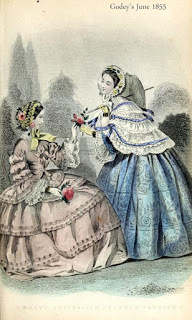 June 1855 fashions
Loretta reports:
June 1855 fashions
Loretta reports:Last month we looked at some 1840s fashions .
This month we move into mid-19th century, where the skirts seem to be belling out more widely. Since Victorian fashion is foreign territory to me, I'm at a loss for intelligent observations, let alone clever ones about these steel engravings from Godey's' Lady's Book for 1855. I do love the flowers and lace framing the ladies' faces, under hat brims.
Given my ignorance, it would be fun to at least be able to do some compare and contrast with British fashion magazines from the era. Unfortunately, as is the case with the 1840s, it’s not easy to find fashion plates online, or when one does, they lack descriptions.*
Re today's descriptions: Guipure, for those of us who are ignorant of dressmaking terms, is a lace. Blonde , as my readers will be aware, is also a lace, the handmade version being quite expensive and thus an excellent way to display wealth.
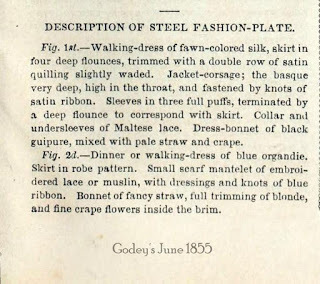 1855 fashion description
*Warning: Rant follows in brackets[While I’m grateful that somebody saved colored fashion plates, and they ended up in museums and libraries, it would have been much better had the entire magazine been preserved, to provide valuable insights into the time period. If saving the whole magazines was too much, people might at least have saved the descriptions, drat them!—end of rant]
1855 fashion description
*Warning: Rant follows in brackets[While I’m grateful that somebody saved colored fashion plates, and they ended up in museums and libraries, it would have been much better had the entire magazine been preserved, to provide valuable insights into the time period. If saving the whole magazines was too much, people might at least have saved the descriptions, drat them!—end of rant]Those of you interested in U.S. Victorian history and fashion may wish to subscribe to Accessible Archives , which has the complete Godey's collection online.
Clicking on the image will enlarge it. Clicking on the caption will take you to the source, where you can learn more and enlarge images as needed.
Published on June 05, 2016 21:30
June 4, 2016
Breakfast Links: Week of May 30, 2016
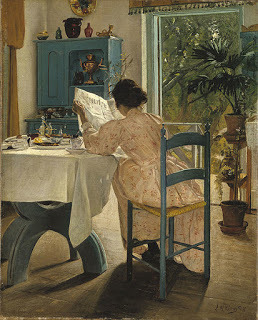 Breakfast Links are served - our weekly round-up of fav links to other web sites, articles, blogs, and images via Twitter.
Breakfast Links are served - our weekly round-up of fav links to other web sites, articles, blogs, and images via Twitter.• Art under the microscope: a close-up look at the silver-wrapped threads of a tapestry.
• Not fiction: Elizabeth Bennett, blacksmith at Blenheim 'Castle'.
• The Emperor Nero and the history of sunglasses .
• Was this going to be Marie-Antoinette's home if she'd escaped? Versailles on the Susquehanna.
• Conserving an 18thc gentleman's coat of many colors.
• Image: Florence Nightingale's writing case.
• Brief video timeline of children's shoes from the collection of the Museum of London.
• "Limbs not yet rigid": a history of dissecting the living ::shudder::.
• The 18thc tax on gloves .
• Marital coercion and the wife who got away, 1844.
• Image: 19thc embroidered silk waistcoat with paddle steamers.
• Nineteenth century blogs for stamping embroidery patterns .
• Why the first cremation in America in 1876 was so controversial.
• World War Two through the lens of an African American soldier.
• A selection of early fashion and cloth trade-cards .
• Image: Well, this is awkward ....
• Who was the King of the Beasts i n New France?
• Sumptuous 16thc Florentine portfolio binding.
• Arson and rural poverty in 1830 - and the grim consequences.
• A fanciful (and terrifying - those insubstantial railings!) view of a future journey by airship from New York to Chicago in twelve hours, 1919.
• Truly retro recipe : ham banana rolls, 1947.
• Image: Good job by the Royal Mail, who managed to deliver this letter in 1898 despite its vague yet artistic address.
Hungry for more? Follow us on Twitter @2nerdyhistgirls for fresh updates daily.
Above: At Breakfast by Laurits Andersen Ring. Private collection.
Published on June 04, 2016 14:00
June 3, 2016
Friday Video: English Through History, or, Ch-Ch-Ch-Changes
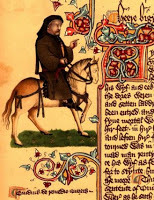 Loretta reports:
Loretta reports:In a college seminar on Chaucer, we were required to learn to read and speak Middle English. Until then, I hadn’t realized the sound of English is not only slightly different from one locality to another, but can sound like another language entirely, depending on what century you’re in.
I wish today’s video creators had stuck with English English speakers throughout, since the change of accents adds a layer of confusion, I think. We Yanks started out with a fairly modern English which we gradually transformed into our own variety. That could form a program in itself, as could the English of Australia and New Zealand and India and everywhere else the language invaded.
Some, too, would disagree about how recognizable Shakespeare’s English would be to modern ears, and not just in terms of our ability to recognize words. Still, the point is made about English’s evolution, and our nerdy history readers are welcome, as always, to comment.
Image: Chaucer as a pilgrim from Ellesmere Manuscript in the Huntington Library in San Marino, California, via Wikipedia.
Readers who receive our blog via email might see a rectangle, square, or nothing where the video ought to be. To watch the video, please click on the title to this post.
Published on June 03, 2016 06:44
June 1, 2016
Dressed for 1775: The Tailor's Intern, Colonial Williamsburg
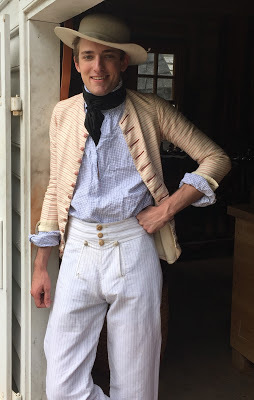 Isabella reporting,
Isabella reporting,Whenever I'm visiting Colonial Williamsburg in the summer months, I always try to share photographs of the summer interns from the Margaret Hunter shop. Not only does the summer internship program provide valuable hands-on experience for college students who are studying historic clothing, construction, and fashion, but it also fills the shop with younger workers - workers whose ages more closely coincide with their counterparts in the 18thc.
It's easy to forget how young the Georgian labor force could be. Extended schooling was a luxury for the upper classes, child labor laws did not exist, and the entire concept of the teenager is a twentieth century invention. Most young people worked, often at an age when we'd still consider them children. Chimney sweeps, cabin boys, scullery maids, and workers in the mines, mills, and factories toiled long hours in hazardous condition for little pay. By comparison, an apprenticeship with a mantua-maker (dressmaker) or tailor offered the opportunity to learn a skilled trade, and the possibility of relative security and success.
Ike Cech, above, is one of the tailor's 2016 summer interns (I'll share the mantua-maker's interns soon.) A student at the University of Wisconsin Madison, Ike is studying textile and fashion design with a focus on historic design. This is Ike's second summer at Colonial Williamsburg; last year he was part of the team sewing the reproduction of General Washington's marquee, or tent (see more about the tent here .)
It was hot and humid today in Williamsburg, and Ike shows how an 18thc Virginian would have dressed for the summer weather while keeping an eye on London fashion. He's wearing loose, lightweight striped trousers, a checked linen shirt, and a black silk neckerchief. His striped jacket is a light wool and worn open (see the same jacket here worn buttoned for a very different look.) The final jaunty touch: a white felted wool hat, the summer version of the ubiquitous black hat worn by most 18thc Englishmen.
Photograph ©2016 by Susan Holloway Scott.
Published on June 01, 2016 21:00
May 30, 2016
Politicians Take It Easy in 1835
 Taking It Easy
Loretta reports:
Taking It Easy
Loretta reports:Figaro in London was one of several 19th-century publications featuring satire and caricature. Among the famous names in this business were George Cruikshank (whose caricatures have often adorned our blog posts), William Hone, and Leigh Hunt.
Since we’re unfamiliar with the individuals and issues being mocked, with varying degrees of savagery, much of the satire can be impenetrable to us.
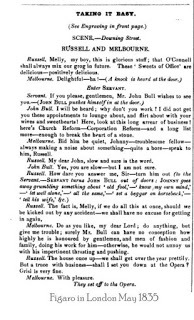 In this case, though, I think readers will have no problem relating to
Figaro’s satire about legislators
—fair or unfair—who seem to have mastered the art of, as Charles Dickens put it,
How Not To Do It
(please scroll down to Chapter X).
In this case, though, I think readers will have no problem relating to
Figaro’s satire about legislators
—fair or unfair—who seem to have mastered the art of, as Charles Dickens put it,
How Not To Do It
(please scroll down to Chapter X). Lord Melbourne
Lord Melbourne

Images: Head shot of Lord Melbourne from Wikipedia (detail from copy of larger portrait by John Partridge at National Portrait Gallery).
Head shot of Lord Russell via Wikipedia (detail from larger portrait by Lowes Cato Dickinson at National Portrait Gallery).
If you look up these gentlemen at the National Portrait Gallery, you’ll find numerous paintings and sketches, including somewhat younger versions of themselves, closer to the time of the Figaro piece.
Satiric image, "Taking It Easy ," from Figaro in London.
Clicking on the image will enlarge it. Clicking on the caption will allow you to read at the source, where you can learn more and enlarge images as needed.
Published on May 30, 2016 21:30
May 29, 2016
From the Archives: Bugler's Cry: The Origin of Sounding Taps
Isabella reporting,
It's been a few years since we last shared this short video, but I can't think of a better time to post it again. The bugle call known as Taps is over 150 years old, and from the first notes it's both instantly recognizable and hauntingly evocative – and especially appropriate for Memorial Day in America.
If you receive this post via email, you may be seeing a black box or empty space where the video should be. Please click here to view the video.
Published on May 29, 2016 17:28
May 28, 2016
Breakfast Links: Week of May 23, 2016
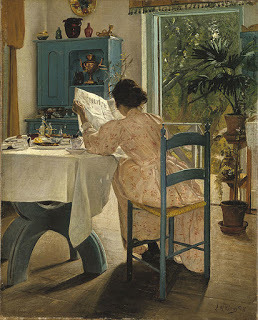 Breakfast Links are served - our weekly round-up of fav links to other web sites, articles, blogs, and images via Twitter.
Breakfast Links are served - our weekly round-up of fav links to other web sites, articles, blogs, and images via Twitter.• Arch enemies: a (sometimes uncomfortable) social history of the high heel .
• Unearthing the lost gardens of poet Emily Dickinson .
• Finally: Congress approves Arlington burials for female WWII pilots .
• The extraordinary life of Marianne North, the Victorian gentlewoman who traveled the world.
• Image: A mother and young son make flower garlands, c1911-14.
• For better or worse: origins of several popular good and bad luck charms .
• How England's first feline show countered Victorian snobbery about cats , 1871.
• Strange encounter: when Princess Caroline met Empress Marie Louise.
• Child actors were kidnapped to order in Shakespeare's day.
• In the days before plastic bags: parcels and boxes for textile purchases in the 19thc.
• The New York Times regrets the error , but readers don't.
• Image: Hannah Stilley , born in 1746 and photographed in 1840; one of the earliest born individuals captured on film.
• The Jacobite mystery of Cluny's cage .
• The rediscovery of Alexander Hamilton's working papers .
• Reproduction of garments for a young 18thc New England woman, from the 1738 probate inventory for Sarah Williams.
• Image: Young women at a domestic training schoo l, 1938.
• Agnes Sorel , 15thc mistress of the French king.
• What it's like to be an historical advisor for A-list movies.
• Unearthing the secrets of New York's mass graves .
• Why are there so few knitting patterns in early recipe books?
• How horses helped cure diphtheria .
• Image: Sometimes the best pieces in a costume collection come with a story of love attached.
• The New England teachers who invented New Math in 1788.
• Rediscovered photo album shows ill-fated granddaughter of Queen Victoria in happier childhood days.
• The haunted doll of Hokkaido, whose hair won't stop growing.
• " Flower power " to aid 18th-19thc beauty.
• What a difference twenty years makes: two very different 19th trips from Boston to California .
• Image: Just for fun: Calvin & Hobbes explain writer's block .
Hungry for more? Follow us on Twitter @2nerdyhistgirls for fresh updates daily.
Above: At Breakfast by Laurits Andersen Ring. Private collection.
Published on May 28, 2016 13:26
May 26, 2016
Friday Video: Lace in 18thc Virginia
Isabella reporting,
Today nearly all lace is produced by machine, and as a result it decorates everything from lingerie to t-shirts and doll clothes. Lace has lost some of its cachet - but once handmade lace was as valuable and treasured as a piece of fine jewelry. This video from George Washington's Mount Vernon features Sarah Woodyard, journeywoman mantua-maker, and one of our favorite historic tradespeople from Colonial Williamsburg . Using reproductions made in the shop as examples, Sarah explains the importance of lace to fashionable 18thc Virginians.
If you received this post via email, you may be seeing a black box or empty space where the video should be. Go to http://twonerdyhistorygirls.blogspot.com to watch the video.
Published on May 26, 2016 21:00
May 25, 2016
Wanstead House, Its Heiress, & Her Unfortunate Choice in Men
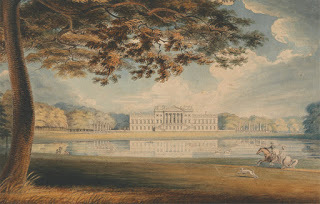 Richard Westall, Wanstead House
Loretta reports:
Richard Westall, Wanstead House
Loretta reports:The clipping from the Annual Register sent me off in 2NHG search of more, as you’d expect, and boy, did I find a story, straight out of melodrama: Young Heiress Ruined By Fortune-Hunting Scoundrel.
A site devoted to Wanstead House tells the story here .
 Annual Register May 1823
Further searching led me back to a beautifully illustrated
site for Wicked William Pole-Tylney
, which Isabella had very recently called to my attention for an altogether different nerdy historical reason (a lovely
post on coaching inns
). And which included
an advertisement for the auction
of the house’s contents the previous year.
Annual Register May 1823
Further searching led me back to a beautifully illustrated
site for Wicked William Pole-Tylney
, which Isabella had very recently called to my attention for an altogether different nerdy historical reason (a lovely
post on coaching inns
). And which included
an advertisement for the auction
of the house’s contents the previous year.Geraldine Roberts, who’s written a book about Catherine Tylney Long, The Angel and the Cad, outlines the heiress's story on her website, with many fine images, including the (rare) one of Catherine below.
 William Pole-Tylney
William Pole-Tylney
 Catherine Tylney LongImage at top:
Richard Westall, Wanstead House
, undated (I’d guess about 1790s), courtesy Yale Center for British Art.
Catherine Tylney LongImage at top:
Richard Westall, Wanstead House
, undated (I’d guess about 1790s), courtesy Yale Center for British Art.Clicking on the image will enlarge it. Clicking on the caption will take you to the source, where you can learn more and enlarge images as needed.
Published on May 25, 2016 21:30
May 23, 2016
What to Learn from Miss May, 1781
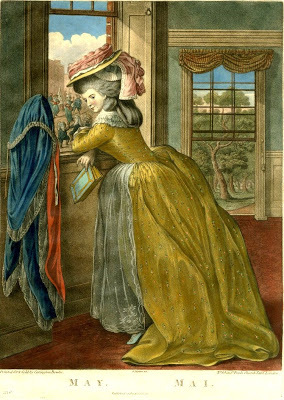 Isabella reporting,
Isabella reporting,Last month Loretta and I had the pleasure of speaking at the annual conference of the New England Chapter of Romance Writers of America. Ostensibly our topic was busting a few historical myths that turn up all too often in historical romances, but because it was us and we like to talk, we made several other points about research as well. Two of our favorites: popular prints can be great sources of historical information, and, conversely, don't take everything you see (or read) at face value.
This print, right, would've made a perfect example. Pretty young women seem to have always been used to illustrate the calendar months, and this lady coyly glancing over her shoulder represents May, 1781. She's one of a set of twelve prints that could have been purchased together or individually. Hand-colored prints like this were increasingly popular in the 18thc, whether framed or simply pinned to the wall, where they added a touch of fashionable gentility in homes and businesses that couldn't necessarily afford paintings.
Miss May is dressed so elegantly and so on-trend that she could almost be considered a fashion plate. Strewn with woven flowers, her silk dress was called an Italian gown, with a close-fitting bodice, long narrow sleeves, and a great deal of fullness in the back. Open in the front, the gown would have been worn over a matching petticoat. She's also wearing a sheer embroidered apron that's purely decorative, as well as a ruffled kerchief. Her silk-trimmed straw hat is tipped forward over a pleated cap, and hanging beside her is her hooded cloak, also trimmed with lace.
So what about her appearance and attire is a faithful representation of women's dress in 1781, and what's exaggerated? It's safe to say that her tiny little foot in its tiny little shoe wasn't really that tiny; surviving shoes from the period prove that English women's feet were in proportion to the rest of them. Her dramatic hairstyle was accurate (see our earlier posts here and here on 18thc big hair), but to make her hair and hat more stylishly impressive by comparison, the artist seems to have shrunk her face. And that ample posterior? That, perhaps surprisingly, is accurate, and would have been achieved with the help of a false bum or rump - pillow-like enhancements that were tied around the waist to support the skirts and give a come-hither wiggle to the walk. (See more about false bums here.)
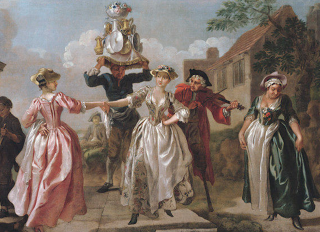
But there are other things to learn from this print, too. Because it's May and spring is here, the lady has not only put aside her cloak, but opened the windows in her house, too. Of course those windows have no screens; wire screens don't become affordable and widely used until the 19thc, and even then they're much more common in America than in Europe (they still are.) The window behind the lady appears to be tall enough to be used as a doorway when raised, leading to a path through the park.
There's also another indication that May has arrived. The scene in the street that the lady is watching is a May Day (the first of May) celebration called the "Milkmaid's Garland", which is also illustrated in the painting, right. To quote the Victoria & Albert Museum's caption:
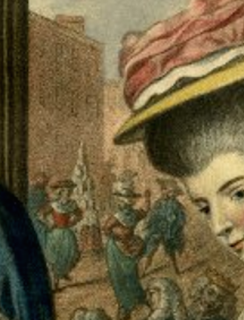
"One of the ancient customs observed on May Day that persisted until the early 19thc was the 'Milkmaid's Garland.' The milkmaids would dress in their best clothes and dance in the streets for their customers. A donation from the customers and from passers-by was expected. A 'garland' - a pyramid of borrowed silver tankards, plates, and flagons decorated with flowers - was paraded by the milkmaids or carried, as in this painting, by a porter."
I'm sure that the grotesque figures also dancing in the street - probably with oversized masks - have something to do with an 18thc May Day as well, but I haven't discovered exactly what. Does anyone among our scholarly readers have the answer?
Left: May/The Twelve Months, published by Carrington Bowles after Robert Dighton, London, 1781. The British Museum.
Right: Detail, The Milkmaid's Garland, or the Humours of May Day, by Francis Hayman, 1741-1742, Victoria & Albert Museum.
Published on May 23, 2016 18:16



